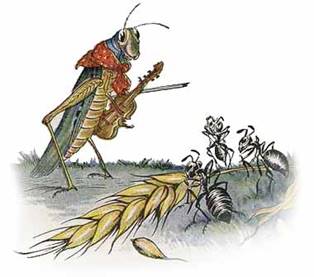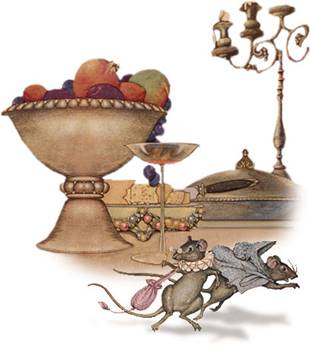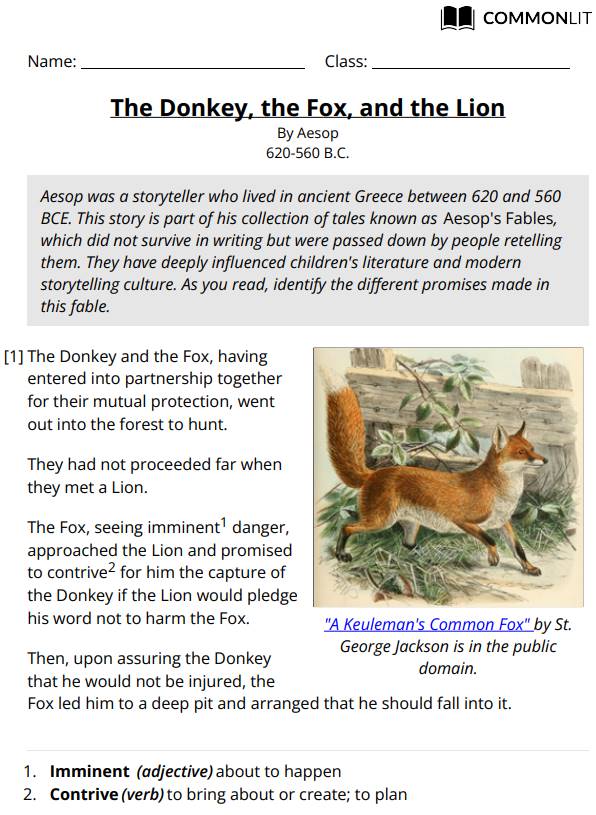
READING LITERATURE: Fable
Unit Key Vocabulary
fable
characters
moral
myths
legends
fairytales
|
Overview
In this unit, you will learn about fables and the
related questions that might appear on the State Assessment. Above, you will
find a list of key vocabulary for this unit.
Fables
A fable is a short, narrative story, often utilizing animals or
inanimate objects as characters, that delivers a moral lesson or ethical
guideline.
The characters in a fable typically personify human qualities, such as
greed, kindness, wisdom, or foolishness, and the story concludes with an
explicit or implicit moral.
Every fable has a moral. A moral is a lesson or truth about life.
"Look before you leap" is an example. The moral might be found at the
end of the fable. It could be something the characters learn or a lesson for
the reader. Details from the fable will support the moral.

Let's consider a fable example to give you a
better understanding:
Title: "The Tortoise and the Hare"
In this
fable, a hare, known for its speed, taunts a slow-moving tortoise. The tortoise
challenges him to a race in response to the hare's arrogance. The hare,
confident that he would win because he's much faster, accepts the challenge.
When the
race starts, the hare quickly leaves the tortoise behind. Confident of his
inevitable victory, the hare decides to nap midway through the course.
Meanwhile, the tortoise continues to move slowly but steadily, never stopping.
When the hare awakens, he finds that the tortoise is about to cross the finish
line. The hare races towards the end but arrives just as the tortoise has won.
Moral:
"Slow and steady wins the race."
This fable
illustrates that overconfidence can lead to complacency, while consistent
effort, no matter how slow, will ultimately lead to success. The animals in the
story—tortoise and hare—embody human traits, such as humility, persistence
(tortoise), arrogance, and laziness (hare).

Fables like
this one are an effective way to teach children important life lessons in a way
that is accessible, engaging, and easy to understand.
Fables are
closely associated with fairy tales. While fairy tales can also feature talking
animals, they don't have to feature a solid moral or
lesson as fables do. Fairy tales focus more on entertainment, often with
fanciful pops of magic and color.
Myths, Fables, Legends, and Fairy
Tales
Below is a
list of characteristics.
|
Myths
|
Fables
|
Legends
|
Fairy
Tales
|
Definition
|
Often
rooted in a particular culture or religion, traditional stories explain some
natural or social phenomenon. Usually involve gods, supernatural beings, or
ancestral heroes.
|
Short
tales teach a moral lesson, often with animals or inanimate objects as
characters that display human traits.
|
Semi-true
stories rooted in historical facts, but often embellished over time. Often
feature heroic characters, memorable deeds, or mysteries.
|
Stories
involving magical and imaginary beings and lands, usually meant to entertain
or teach a lesson, with elements of good and evil.
|
Purpose
|
Explain
natural or societal phenomena, and convey cultural or moral values.
|
Teach a
moral or lesson.
|
Preserve
historical events, teach a moral or lesson, and inspire.
|
Entertain,
often teach a moral or lesson, sometimes to caution about danger.
|
Characters
|
Gods,
goddesses, supernatural beings, heroes.
|
Animals
or inanimate objects with human traits.
|
Heroic
or influential historical figures, sometimes with supernatural powers.
|
Princes,
princesses, witches, wizards, talking animals, or magical creatures.
|
Elements of Truth
|
Generally
considered fictional or symbolic.
|
Generally
fictional.
|
Often
have a kernel of truth based on historical figures or events.
|
Generally
fictional.
|
Supernatural
Elements
|
Yes,
they commonly involve gods or supernatural powers.
|
Sometimes,
depending on the story.
|
Sometimes,
particularly as stories are embellished over time.
|
Yes,
they often involve magic or magical creatures.
|
Origin
|
Ancient
cultures and religions.
|
Ancient
cultures.
|
Based on
real historical events or figures, though often distorted or exaggerated over
time.
|
Various
cultures often passed down through oral tradition
|
Aesop’s Fables
Aesop is quite
possibly the most famous fable writer of all time. We don't know everything
about him, but people believe he was enslaved in Greece and wrote much of his
work around 550 B.C. Many of the morals in his fables revolve around equality,
justice, and virtuous behavior. Without question, Aesop created a treasure
trove of fables for children to read and draw lessons from.
Below are some of Aesop's fables:
A.
The Ant and the Grasshopper
In this fable, sometimes titled The
Grasshopper and the Ant(s), the ant saves winter food, but the grasshopper does
not. When winter comes, the hungry grasshopper begs for food, but the ant
refuses to share. The moral is, "Prepare for the days of necessity."

B.
The Country Mouse and the City Mouse
In this fable, the city mouse takes
the country mouse to the city to sample the fine food there. During the meal,
two dogs scare the mice, and the country mouse returns home, where he is safe.
The moral is, "Better beans and bacon in peace than cakes and ale in
fear."

PASSAGE

Click
here for the pdf version.

Below is an
additional educational activity for this unit.